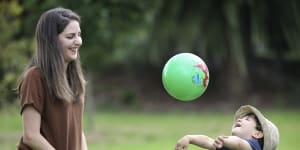Roughly one in 10,000 babies are born with spinal muscular astrophy,a disorder similar to motor neurone disease which causes muscle weakness. For Jonathan,the impact the condition – diagnosed at birth – will have on his life was reduced substantially when he received access to gene therapy before he turned five months old.

Gemma Najem with her son Jonathan (aged 2) who has received life-saving spinal muscular atrophy treatment from viral vector therapy.James Alcock
Although she is grateful for the treatment he did receive,Ms Najem said she was aware that,had Jonathan been born a little later,or in a different place,maybe he would not need her help to jump.
“In America,where the gene therapy was developed,there are kids being treated pre-symptomatically now,” she said. “A child can be picked up as needing therapy,treated and may never need mobility equipment.”
You may have heard the term “viral vector” in recent years referring to the AstraZeneca and Johnson&Johnson COVID-19 vaccines. But viral vectors – microscopic tools which deliver genetic material into cells – were first developed in the 1970s and,even before the pandemic,were providing hope in the treatment of rare cancers and genetic diseases through gene therapy.
The NSW government is hoping western Sydney can become a world-leader in viral vector manufacturing,with a more than $25 million investment in a facility at Westmead,the first commercial scale facility in Australia.
Professor Ian Alexander,head of the gene therapy research unit at Sydney Children’s Hospital,said although gene therapy has been around for more than 25 years,there had been significant developments in the past three to five.
“I used to joke,‘If you’re a sick mouse,come and see me.’ But we are at an inflection point in gene therapy:now we are no longer looking to just cure another mouse in a laboratory,” he said.
While previously gene therapy,such as the treatment Jonathan received,focused on replacing whole genes,Professor Alexander said recent developments meant the therapy could also be “more like editing a manuscript”.
“If you find an error in the third paragraph,you can edit the gene. This is the ultimate precision in genetic repair,” he said.
Research teams across the world are trialling and rolling out life-changing treatment using the technology,including T-cell therapy for cancer,and therapies for rare genetic eye,muscle and liver conditions.
Professor Alexander said while Australian researchers “punch above their weight” in the field,his team recently experienced the impact of having no large-scale local facility when they developed a therapy for children with urea cycle disorder,a condition which necessitates a liver transplant. The viral vector had to be manufactured offshore and will not be ready until later this year.
“The developments were here in Australia,but to bring it to fruition we had to go to the US and wait in quite a long queue,” Professor Alexander said.
He said there was already interest from other research institutes in the use of the Westmead facility. Expressions of interest for co-investment from international research teams will open this week.
“With gene therapies and COVID-19 vaccines straining global manufacturing capacity in recent years,viral vector manufacturing services are in high demand worldwide,” Health Minister Brad Hazzard said.
“In Australia alone,we have two million people living with a genetic disease. Local production will ensure we can run more research trials and increase treatment options.”
Liam Mannix’s Examine newsletter explains and analyses science with a rigorous focus on the evidence. to get it each week.